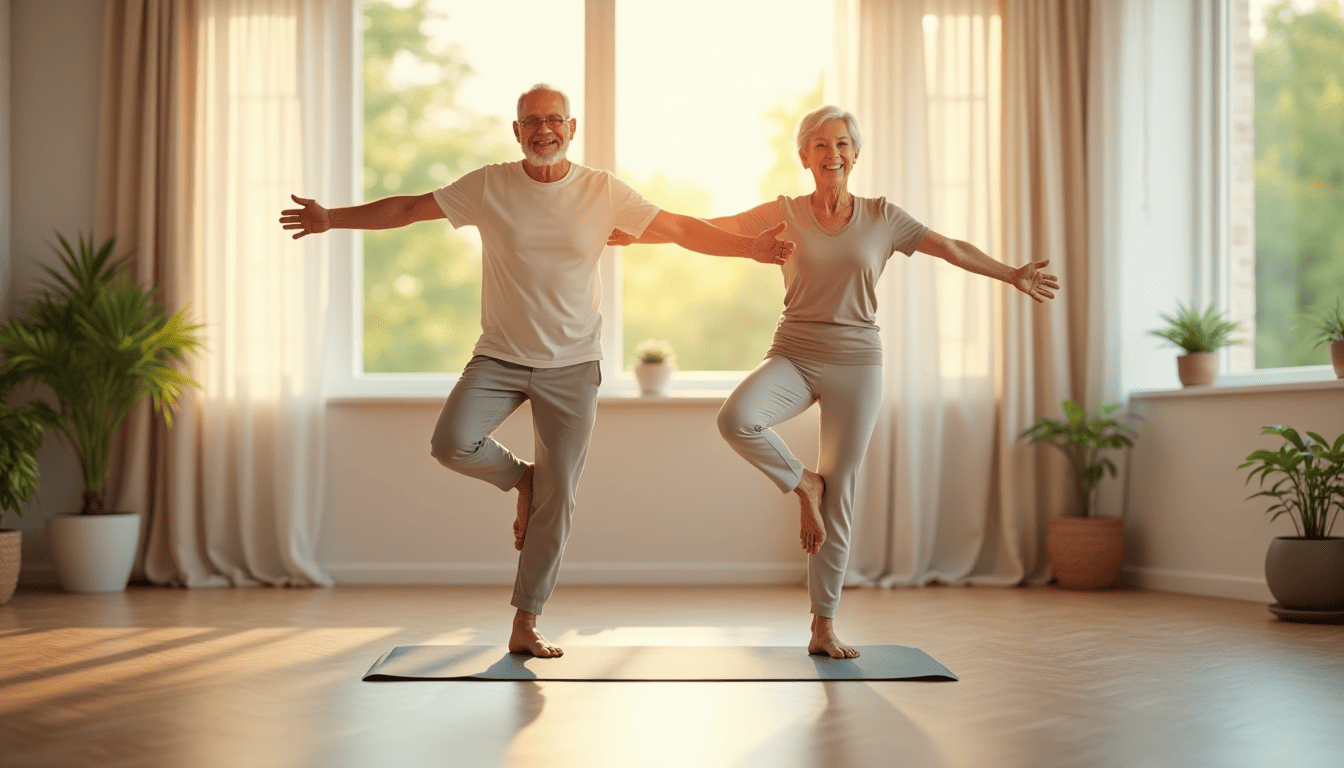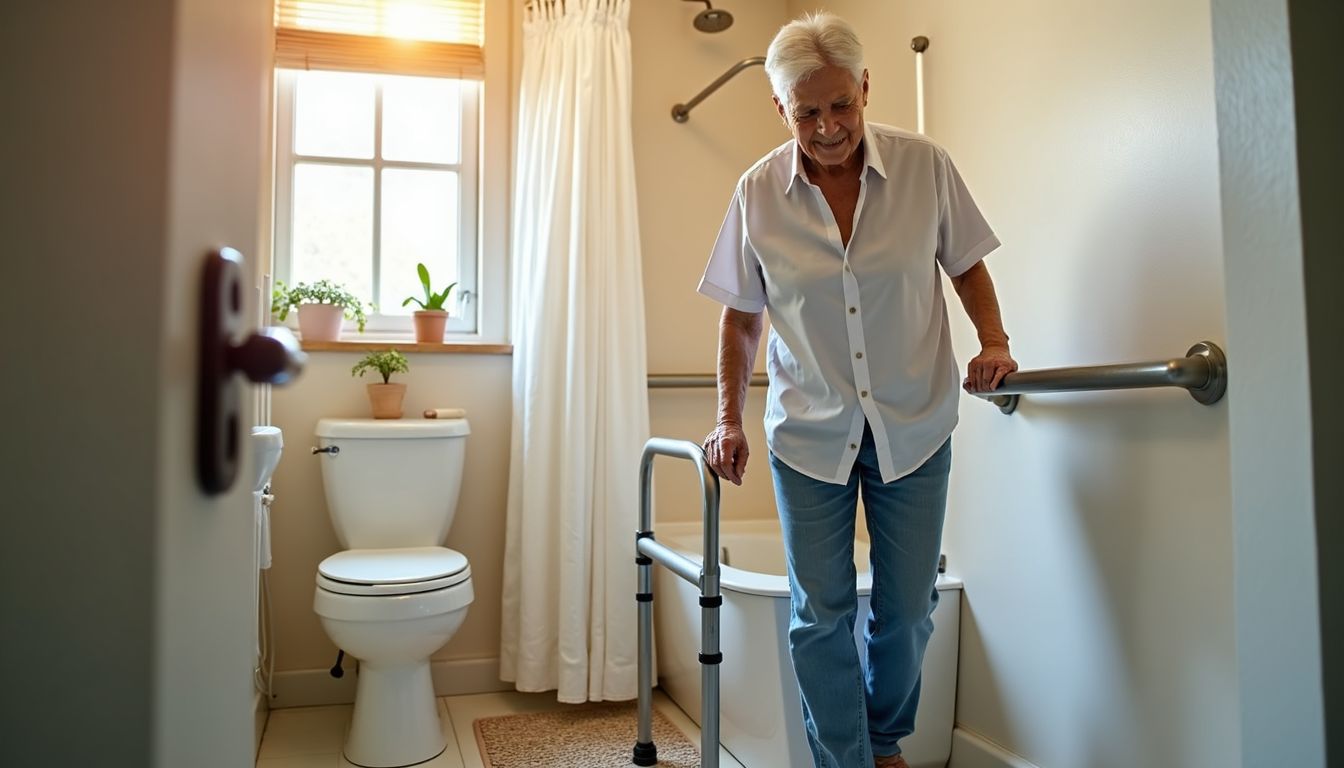As we age, maintaining balance becomes increasingly important for staying safe and independent. Poor balance can lead to slips, trips, and falls, which are a leading cause of injuries among seniors. The good news is that simple, regular exercises to improve balance in seniors can make a big difference. These exercises strengthen muscles, improve coordination, and boost confidence, helping older adults stay steady on their feet during daily activities. Whether you prefer gentle chair-based movements or light standing exercises, incorporating balance training into your routine can greatly enhance mobility and overall well-being.
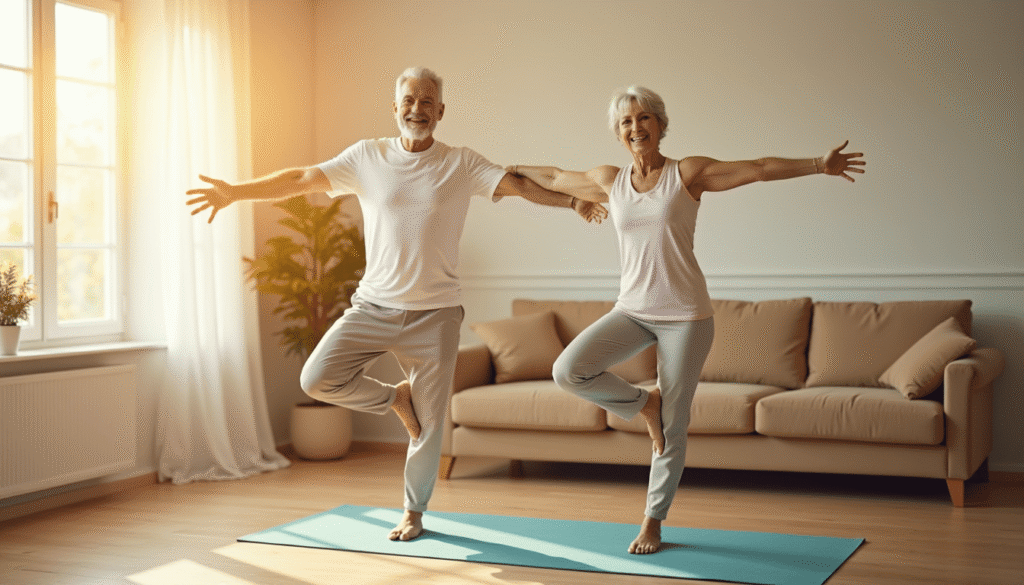
2) Benefits of Balance Exercises for Seniors
Maintaining good balance is essential for seniors to live independently and reduce the risk of falls. Regular balance exercises for seniors offer numerous physical and mental benefits:
-
Fall Prevention: Strengthening core and leg muscles helps reduce the likelihood of slips and falls, one of the most common causes of injuries in older adults.
-
Improved Mobility: Better balance enhances walking stability, making it easier to perform daily tasks like climbing stairs, getting out of a chair, or walking outdoors.
-
Increased Strength and Flexibility: Balance exercises often engage multiple muscle groups, improving overall strength, flexibility, and joint stability.
-
Enhanced Confidence: Seniors who practice balance exercises regularly feel more secure in their movements, reducing fear and hesitation in daily activities.
-
Mental Benefits: Many balance exercises also improve focus, coordination, and body awareness, supporting cognitive function alongside physical health.
Incorporating simple balance exercises for seniors into a daily routine can be a game-changer for maintaining independence, safety, and overall quality of life.
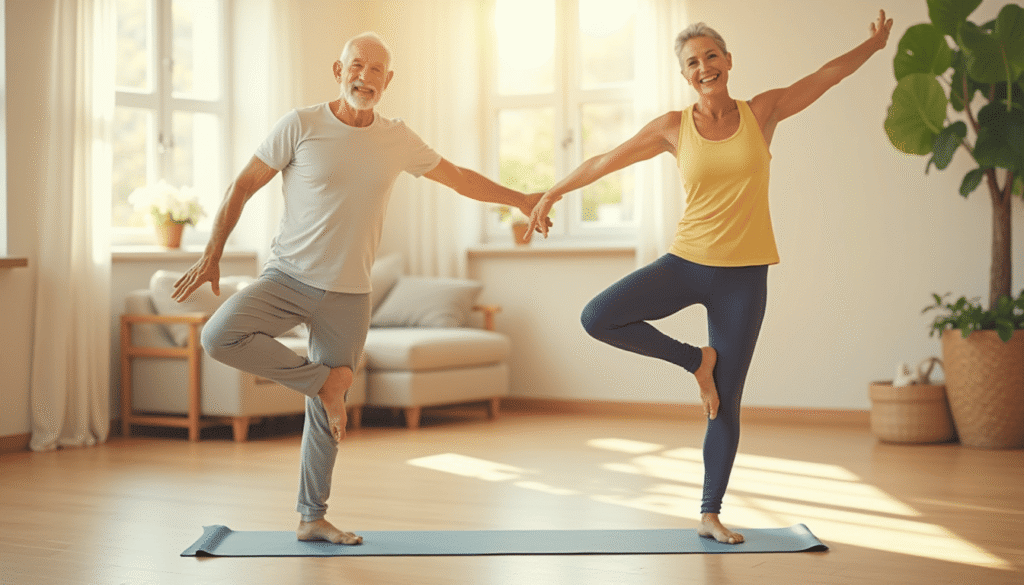
Top 10 Exercises to Improve Balance in Seniors
Maintaining balance is crucial for seniors to prevent falls and stay independent. These 10 simple exercises can be done at home, with minimal equipment, to improve strength, coordination, and stability.
1. Heel-to-Toe Walk
How to do it: Stand straight and walk in a straight line, placing the heel of one foot directly in front of the toes of the other foot. Keep your eyes forward and arms relaxed at your sides.
Benefits: Improves walking stability, posture, and coordination.
Tips: Start near a wall or counter for support until you feel confident.
2. Single-Leg Stand
How to do it: Stand behind a chair or near a wall. Lift one foot off the ground and balance on the other leg for 10–15 seconds. Switch legs.
Benefits: Strengthens leg muscles, improves balance, and enhances core stability.
Tips: Hold the back of a chair if needed. Gradually increase the duration as your strength improves.
3. Side Leg Raises
How to do it: Stand behind a chair and hold the backrest for support. Lift one leg out to the side, hold for 3–5 seconds, then slowly lower it. Repeat with the other leg.
Benefits: Strengthens hips and thighs, improves lateral stability, and helps prevent falls.
Tips: Keep your torso upright and avoid leaning to the side.
4. Marching in Place
How to do it: Stand tall with feet hip-width apart. Lift one knee at a time as if marching, alternating legs. Swing your arms naturally.
Benefits: Builds lower body strength, enhances coordination, and promotes circulation.
Tips: Start with 30 seconds and gradually increase the duration as endurance improves.
5. Sit-to-Stand Exercise
How to do it: Sit in a sturdy chair with feet flat on the floor. Cross arms over your chest or keep hands on thighs. Slowly stand up fully, then sit back down. Repeat 10–15 times.
Benefits: Strengthens quadriceps, glutes, and core muscles; improves functional mobility for daily tasks.
Tips: Ensure the chair doesn’t slide. Use your legs more than your arms for support.
6. Heel Raises
How to do it: Stand with feet shoulder-width apart, holding a chair or counter for support. Slowly raise your heels off the ground, balancing on your toes, then lower back down. Repeat 10–15 times.
Benefits: Strengthens calves, improves ankle stability, and enhances walking balance.
Tips: Move slowly to maintain control. Avoid bouncing.
7. Toe Raises
How to do it: Stand tall with feet hip-width apart, using a chair or wall for support. Lift your toes off the ground while keeping your heels down, then lower back. Repeat 10–15 times.
Benefits: Strengthens the front lower leg muscles and improves ankle mobility.
Tips: Keep knees straight but not locked. Perform slowly for best results.
8. Standing Hip Marches
How to do it: Stand behind a chair for support. Lift one knee up toward your chest, then lower it and repeat with the other leg, as if marching in place.
Benefits: Strengthens hip flexors, improves core stability, and enhances balance.
Tips: Focus on controlled movements and engage your abdominal muscles.
9. Side-to-Side Steps
How to do it: Stand tall and take a step to the right, then bring the left foot to meet it. Repeat 10–15 steps, then step to the left.
Benefits: Strengthens legs, improves lateral movement, and enhances stability.
Tips: Keep your core engaged and avoid leaning too far to one side.
10. Chair Yoga Balance Poses
How to do it: Perform seated or standing yoga poses like tree pose (stand on one leg, place the other foot on the inner calf or ankle) or gentle seated twists. Hold each pose for 10–15 seconds.
Benefits: Improves core strength, flexibility, posture, and balance.
Tips: Always perform near a sturdy surface, and modify poses based on comfort and mobility.
💡 Pro Tip: Perform these exercises near a wall, counter, or sturdy chair for safety. Start slowly, repeat daily, and gradually increase the duration and intensity to see long-term improvements in balance and stability.
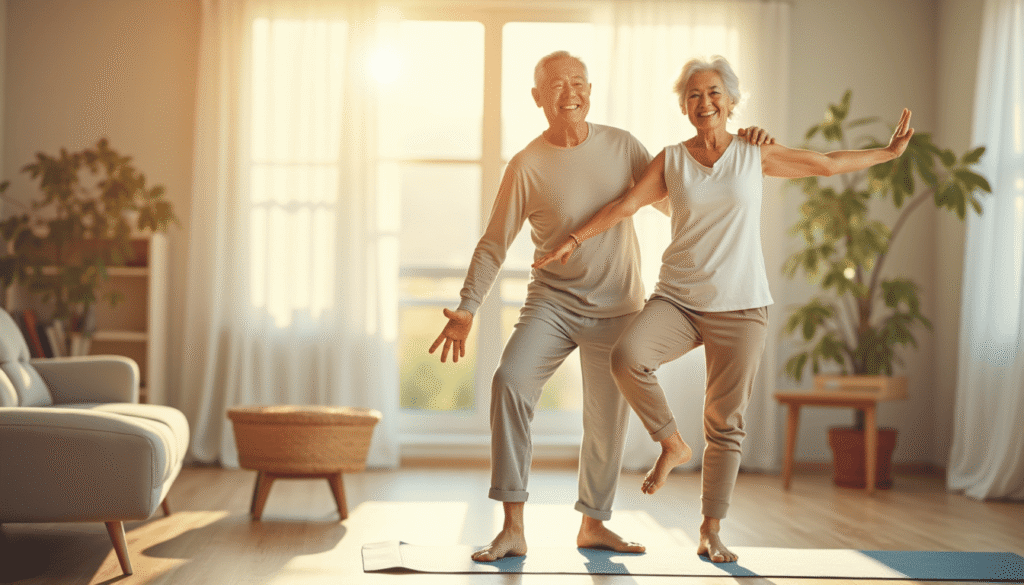
Safety Tips While Doing Balance Exercises
Even simple balance exercises can pose a risk if not done safely, especially for seniors with limited mobility or chronic conditions. Follow these essential safety tips to prevent falls and injuries while exercising:
1. Use Support
Always perform balance exercises near a sturdy chair, countertop, or wall. This provides a safe fallback if you lose balance.
2. Wear Proper Footwear
Choose shoes with non-slip soles and good support. Avoid socks or slippery footwear to reduce the risk of slips.
3. Start Slow
Begin with short sessions and simple exercises. Gradually increase the duration and complexity as your strength and confidence improve.
4. Clear the Exercise Area
Ensure the floor is free from obstacles, loose rugs, or clutter. A clear space minimizes the risk of tripping or falling.
5. Listen to Your Body
If you experience pain, dizziness, or discomfort, stop the exercise immediately. Consult your doctor before resuming or modifying your routine.
6. Stay Hydrated
Drink water before, during, and after exercising. Proper hydration helps maintain energy and prevent fatigue-related balance issues.
7. Consistency is Key
Perform balance exercises regularly, ideally daily. Consistent practice strengthens muscles, improves coordination, and reduces fall risk over time.
💡 Pro Tip: Pair balance exercises with gentle stretching and mobility exercises for overall stability and functional movement.
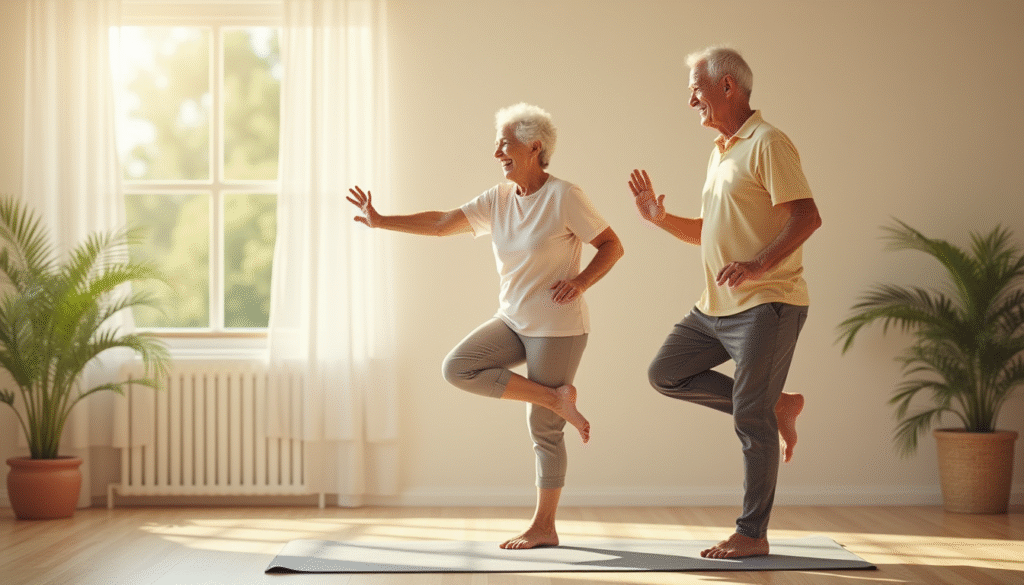
How to Track Your Progress
Tracking progress is an important part of staying motivated and ensuring that balance exercises are effective. Here’s how seniors can monitor their improvements safely and efficiently:
1. Keep an Exercise Journal
Maintain a notebook or digital record of each session. Note the exercises performed, duration, number of repetitions, and any difficulties encountered.
2. Measure Balance Improvements
Simple tests, like timing how long you can stand on one leg or tracking steps taken without support, can show gradual progress over time.
3. Set Realistic Goals
Break your balance training into achievable milestones. For example, aim to increase standing-on-one-leg time by 10 seconds each week.
4. Use Apps or Devices
Some seniors may benefit from fitness apps or wearable devices that track steps, activity, and even stability. These tools provide visual progress reports and reminders.
5. Celebrate Achievements
Acknowledge even small improvements, such as better stability or increased confidence while walking. Celebrating wins boosts motivation and adherence to the routine.
💡 Pro Tip: Regularly reviewing your progress helps adjust exercises to match your growing strength and ensures you are challenging your balance safely.
Safety Tips While Doing Balance Exercises
Safety is crucial when performing balance exercises, especially for seniors. Follow these tips to prevent injuries and get the most benefit from your routine.
1. Use Support When Needed
Always have a sturdy chair, countertop, or wall nearby for support, especially when trying new or challenging exercises.
2. Wear Proper Footwear
Non-slip shoes or supportive slippers help maintain stability and reduce the risk of slipping during exercises.
3. Warm Up Before Exercises
Start with gentle stretching or marching in place to loosen muscles and prepare your body for balance exercises.
4. Avoid Overexertion
Listen to your body and take breaks when needed. Do not push yourself beyond your comfort level.
5. Keep the Exercise Area Clear
Ensure there are no obstacles, loose rugs, or clutter around the workout space to prevent trips and falls.
6. Stay Hydrated
Drink water before and after exercising to maintain energy and prevent dizziness.
7. Consult a Healthcare Provider
If you have any medical conditions or recent injuries, check with your doctor before starting a new balance exercise routine.
💡 Pro Tip: Consistency is more important than intensity. Regular, safe practice ensures steady improvement in balance and confidence.
Conclusion
Improving balance is essential for seniors to maintain independence, prevent falls, and enjoy a more active lifestyle. By incorporating simple exercises into daily routines—like chair stands, heel-to-toe walks, and gentle stretches—seniors can strengthen muscles, enhance stability, and boost confidence.
Remember to follow safety tips, start slow, and gradually increase intensity as your balance improves. Combining these exercises with other mobility and daily living aids, such as Folding Walkers for Elderly, Rollator Walker with Seat, and Swivel Shower Chairs for Elderly, can provide additional support and ensure a safer, more independent life.
Consistency, patience, and proper guidance make all the difference. Start small, stay committed, and enjoy the benefits of improved balance and mobility every day.


